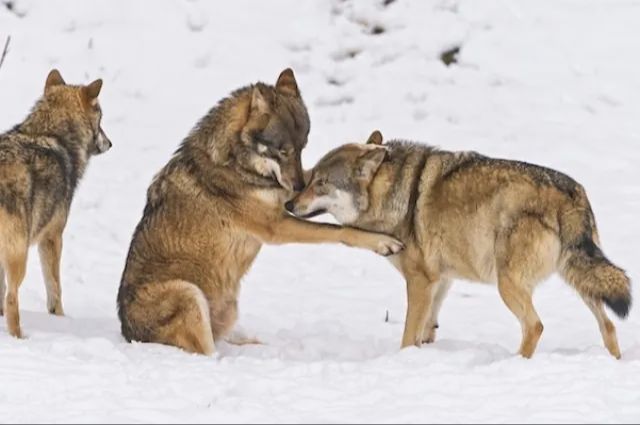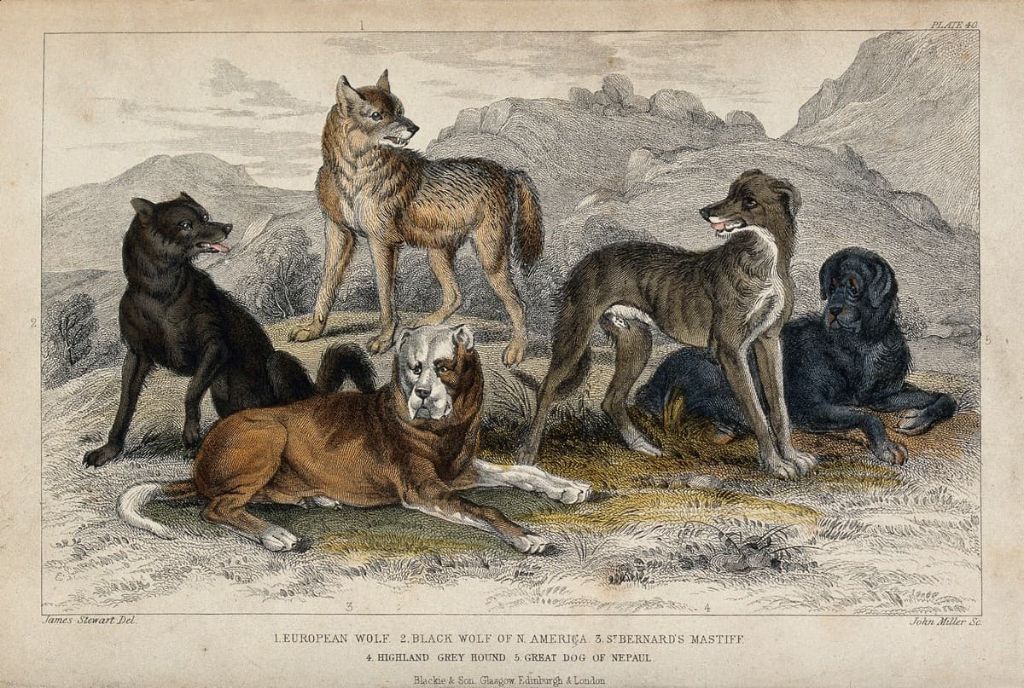Introduction
There is a common misconception that dogs exhibit “pack” mentality and social hierarchies like their wolf ancestors. Many outdated dog training techniques are based on the idea that dogs are “pack” animals that need an “alpha” leader. However, research shows that feral and domesticated dogs do not actually form hierarchical packs in the wild. Dogs are not pack animals in the same way that wolves are.
The notion that dogs have a strict pack mentality comes from early research on wolves. Wolves live in familial packs with defined hierarchies and roles. However, dogs have evolved differently from wolves, and do not adhere to pack structures, even when living completely feral. This article will examine why the “pack mentality” idea is misguided, and can lead to flawed dog training techniques.
Wolf Packs vs Dog Groups
Wolf packs are well-structured social groups made up of an alpha breeding pair and their offspring from multiple generations (1). These family units are hierarchical, with the alpha male and female exerting dominance and control over breeding privileges. Rank is reinforced through displays of submission (1).

In contrast, groups of stray or feral dogs are loose social organizations of mostly unrelated individuals. They do not form structured packs like wolves. While dogs may display dominant/submissive behaviors, they lack a hierarchy around mating privileges or generational family bonds (2).
So while wolves form close family packs with strict hierarchies, groups of dogs are loosely affiliated for basic survival needs without a strict social structure (3). This key difference in social organization is one reason experts caution against applying “pack theory” dominance training to dogs, as they do not actually live in packs like wolves.
Sources:
(1) https://www.petmd.com/8-differences-between-dogs-and-wolves-0
(2) https://www.redstonevet.com/sites/default/files/Dogs-are-not-Wolves-Fear-Free.pdf
(3) https://www.quora.com/In-what-ways-do-wolf-packs-function-differently-from-other-canine-social-structures-such-as-dog-packs
Misinterpreting Dominance Behavior
The idea of dogs as constant vying for dominance and establishing rigid pack hierarchies is inaccurate. The dominance model, popularized by dog trainer Cesar Milan, stems from early research on captive wolf packs in the 1940s and 1950s (source). However, this research has long been debunked by wolf biologists. Wolf packs in the wild are generally made up of extended family groups where the breeding male and female are simply parents and older siblings act as mentors. Aggression within real wolf packs is rare and not linked to establishing dominance (source).
While dogs do exhibit dominance behaviors, this is not usually used to establish top-down pack hierarchy. Instead, displays of dominance, like guarding food or toys, are simply methods dogs use to maintain access to valued resources (source). The dominance model falsely equates this resource guarding behavior to wolf pack dynamics.
Dogs Are Scavengers
Unlike wolves, dogs did not evolve to be cooperative hunters that work together in packs to take down large prey. According to Dr. Raymond Coppinger’s research, early dogs were scavengers that lived on the outskirts of human settlements and survived by eating leftover scraps and garbage.

As scavengers, dogs did not need to coordinate with a pack to find food. They could survive solitarily by scrounging for whatever scraps they could find. This meant dogs did not evolve the same complex social structures and cooperative behaviors seen in wolf packs.
While wolves exhibit sophisticated communication and social coordination to hunt prey as a pack, dogs evolved without this selective pressure. Since they relied on solitary scavenging, dogs do not have an innate “pack mentality” or need to establish social hierarchies and roles within a pack.
Coppinger argues that this key difference between the evolutionary origins of wolves and dogs explains why the idea of establishing yourself as the “alpha” over a dog has no basis in science. Treating dogs like wolves by trying to be the “pack leader” does not align with the scavenging history of domesticated dogs.
Dogs Lack Pack Mentality
Dogs do not have the same innate drive to coordinate and cooperate with a pack like wolves do. Research shows that thousands of years of domestication has selected against strong pack instincts in dogs (Lazzaroni, 2020).
Whereas wolves engage in highly coordinated pack hunting and rearing behaviors, dogs evolved as opportunistic scavengers reliant on human provisioning. This reduced the need for complex social coordination abilities (Hansen Wheat et al., 2019).
While dogs are still social animals, domestication has oriented them to be companions for humans rather than members of highly structured packs. Dog groups show flexible, loose social organization compared to wolf packs.
Owner Replace the Pack
Many studies have shown that domesticated dogs view their owners as the center of their world and as a replacement for the traditional wolf pack structure. Breeding over thousands of years has led dogs to form tight bonds with human families, reducing their need for a pack mentality with other dogs.

One interesting study from the University of Veterinary Medicine found that when given a choice between their owner or even a close canine sibling, dogs overwhelmingly chose to interact with their owner. This indicates that the dog-human bond has replaced the dog’s traditional pack bonding behavior (Source).
It’s clear through modern research that domesticated dogs have adapted to view their human caregivers as their pack. The owner provides food, shelter, affection and structure that would normally come from an animal pack. This intense bond with humans likely developed as dogs became domesticated and less reliant on dog-only packs.
Dog Parks Show Loose Groups
Dog parks illustrate that dogs form loose, random groupings rather than coordinated packs with strict hierarchies. When visiting dog parks, you see dogs freely interacting in fluid ways. They chase and play together, then separate and mingle with others. You don’t see coordinated pack behavior with an alpha dog directing the rest of the pack.
The rough play and chasing seen at dog parks is not evidence of pack hierarchy or dominance. It’s simply natural canine social behavior. As stated by the Association of Professional Dog Trainers, “Some dogs become very reluctant to go into dog parks, which—as we have noted—can be out of control. Others will snarl or snap to indicate their displeasure.” [1] So while dogs are highly social, their groupings are loose and random rather than a strict pack structure.
Pack Training Techniques Flawed
Trainers who subscribe to pack theory often try to establish themselves as the “alpha” or pack leader. This involves using dominance and punishment to gain control over the dog. However, research shows that attempting to dominate dogs in this way is ineffective and outdated.
According to dog trainer Victoria Stilwell, “the idea of being pack leader has caused widespread abuse of dogs.” Trying to assert your dominance can involve harsh corrections, yellling, physical force, and other negative reinforcement. This creates fear, anxiety and stress in dogs.
Positive reinforcement training has been proven more effective for obedience than dominance-based methods. Rewarding good behavior gets better results than punishing bad behavior. As dog expert Chirag Patel explains, “Dominance training promotes the use of punishment and that makes things worse.”
The evidence clearly shows that attempting to dominate your dog as “pack leader” does not work and can damage your relationship. Building trust through rewards and compassion is a more successful approach.
Healthy Socialization, Not Packs
Well-socialized dogs develop dog friendship, not packs. Proper socialization during a dog’s sensitive period between 3-14 weeks old teaches them how to interact politely with other dogs and humans (AVMA). While their group behavior is much looser than a wolf pack, socialized dogs learn dog manners to get along during play at home or at dog parks.
Balanced socialization reduces reactivity and fights. Introducing your puppy to new people, dogs, places, and experiences makes them more comfortable in different environments (Animal Humane Society). With ongoing positive interactions, they gain confidence and learn proper greetings, rather than feeling threatened by unknown dogs or people. This lays the foundation for friendly relationships with other dogs instead of pack behavior.
Conclusion
In summary, there are several key reasons why dogs do not have a pack mentality or social structure:
– Wolves live in packs with complex social hierarchies, but dogs did not evolve in this way. As domesticated scavengers, dogs never needed to hunt in packs.

– Dominance and alpha behaviors in dogs are often misunderstood. These are not signs of pack mentality but normal canine communication.
– Dog “packs” are loose social groups, not hierarchical packs. At dog parks, they interact fluidly without defined roles.
– Attempts to train dogs using “pack leader” or “alpha” techniques are flawed, as they are based on a false premise.
The implications of this are clear – dog owners should focus on positive socialization and training methods that build rapport and communication with their pet. Proper socialization involves controlled exposure to many people, environments, and other dogs. It does not involve establishing pack dominance or leadership. With a better understanding of canine social behavior, we can nurture happy and well-adjusted dog companions.